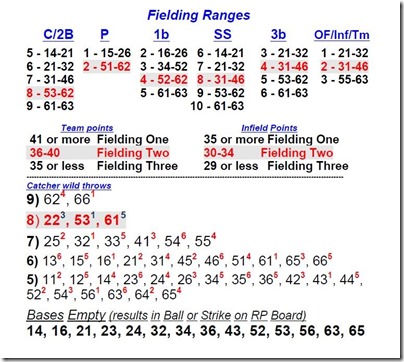Here’s quick primer on what you will find in the Fielding Range Chart.
1) Numerical breaks that quickly define Fielding One, Two, and Three
Each position is listed, accompanied by the numbers that define Fielding Two.
For example, for catchers and 2b rated 5, anything between 14-21 is Fielding Two. Dice rolls between 11-13 are Fielding One. Dice rolls from 22-66 are Fielding Three.
Another example: for outfielders rated 2, or team totals and infield totals rated Fielding Two, a dice roll between 31-46 is Fielding Two. Dice rolls between 11-26 are Fielding One. Dice rolls between 51-66 are Fielding Three.
2) Catcher wild throws
The chart shows each catching grade, accompanied, in superscript (the little number next to the dice roll), the single die roll that defines a potential wild throw, and the necessary single die roll that would result in a wild throw.
For example, suppose you have a C-8. If an opponent steals a base, you would roll two dice. If the result was 22, 53, or 61, you potentially have a wild throw. If you rolled a 22 and then rolled a 3, you would have a wild throw. You would then you would consult APBA’s Wild Throws to Second with Runners on First Only to get the result of the wild throw.
3) A bases empty RP listing of dice rolls that result in a ball, strike, or foul ball
This only works with the bases empty.
With the bases empty, 14 numbers result in either a ball, strike, or foul ball all the way across the RP results board. They are listed under Bases Empty, saving you the time required to consult the RP board. To clarify, this does not apply with men on base, only with nobody on.
The shorthand version of the Fielding Chart does not totally eliminate the Fielding Chart but once you use it for a while, it’s a great time saver. Click here for a pdf version of the Fielding Chart.
Next: Tracking pinch hitting





Very handy, Rod! I may use this!
Tom
Thanks for this!! I am going to start using this right away! Good job!
Doug
Her is where I stick with the basic game, though I do use advanced fielding. One thing i hated when i tried Strat-o-matic was having to mess with fielding range and make repeated rolls on certain plays. I do appreciate all of your helpful articles, though!